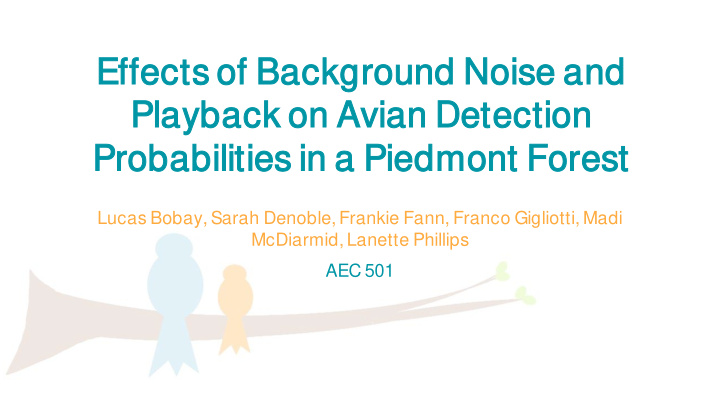



Effects of of Background ound Noi oise and Playback on on Avian D n Detection on Prob obabilities i in a a Piedmont nt F For orest Lucas Bobay, Sarah Denoble, Frankie Fann, Franco Gigliotti, Madi McDiarmid, Lanette Phillips AEC 501
Background Detection during bird surveys is easily affected by many outside variables. One cause of interference is background noise Observers exposed to a 10 dB increase in ambient noise level experience a significant decrease in call detections (Simons et al. 2007)
Objectives Two main questions: 1. What effect does background noise have on bird detection rates on point counts? 2. What effect will broadcasting Eastern Screech-Owl playback have on detection? Implications for future research: Use what we find in planning/development of future point count surveys of wintering forest birds
Methods ● 60 sites, 10 points, close proximity to trails ● Carl Alwin Schenck Memorial Forest, Umstead State Park ● Visited each point 3 times ● Sampling window- 7 am to 10 am, Feb. 27 - Mar. 6 ● Screech Owl playback- every other point, 2 minutes ● Documented every bird heard or seen ● Analyzed data using R for American Crow. Carolina Chickadee, Carolina Wren, Eastern Tufted Titmouse, Northern Cardinal, Pine Warbler, Red-bellied Woodpecker
Team 3 Sample Point Locations Team 1 Map of Raleigh Team 2
Point Coordinates Te Team 1 Te Team 3 Te Team 2
Results Data from 53 points examined for 7 focal species Occupancy models created based on Screech Owl and Ambient Noise covariates Model selection based on AIC Values back-transformed to arrive at occupancy and detection estimates
Discussion Minimal Effect for Screech-Owl Playback Background Noise Negative Effect Variables and Irregularities? Improvements? Uses and thoughts for the future
Literature Cited Altmann, S. A. (1956). Avian Mobbing Behavior and Predator Recognition. The Condor 58: 241-253. Gasc, A., Pavoine, S., Lellouch, L., Grandcolas, P., and J . Seuer. (2015). Acoustic indices for biodiversity assessments: Analyses of bias based on simulated bird assemblages and recommendations for field surveys. Biological Conservation 191: 306-312. Gehlbach, F. R., and J . S. Leverett. (1995). Mobbing of Eastern Screech-Owls: Predatory Cues, Risk to Mobbers and Degree of Threat. The Condor 97(3): 831-834. Mitchell, B. R. (2008). Mob Mentality: Effect of a Mobbing Playback on Avian Detection Probabilities during Point Count Surveys. The Open Ornithology J ournal 1: 8-19. Moller, A.P. (1992). Interspecific response to playback of bird song. Ethology 90: 315-320. Pacifici, K., Simons, T. R., and K. H. Pollock. (2008). Effects of Vegetation and Background Noise on the Detection Process in Auditory Avian Point- Count Surveys. The Auk 125(3): 600-607. Shedd, D. H. (1983). Seasonal Variation in Mobbing Intensity in the Black-capped Chickadee. Wilson Bulletin. 95(3): 343-348. Simons, T. R., Alldredge, M. W., Pollock, K. H., and J . M. Wettroth. (2007). Experimental Analysis of the Auditory Detection Process on Avian Point Counts. The Auk 124(3): 986-999. Turcotte, Y., and A. Desrochers (2002). Playbacks of Mobbing Calls of Black-Capped Chickadees Help Estimate the Abundance of Forest Birds in Winter. J ournal of Field Ornithology 73(3): 303-307. Wilkins, H. D., and M. S. Husak. (2006). Effect of Time and Barred Owl Playback on Winter Detection of Woodpeckers in East-Central Mississippi. Southeastern Naturalist 5(3): 555-560.
Any questions?
Recommend
More recommend